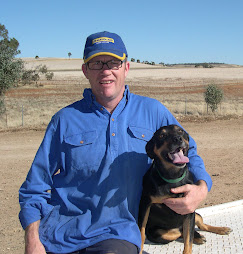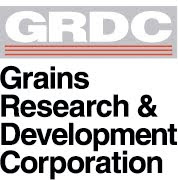Same Gully But Looking Down Gully
2. Extremely Poor Fertility.
3. No Adequate Herbicides For Weed Control, Leading to Weed Blowouts
Carlos bought himself a bulldozer and went to work on the area of gully erosion and reclaimed a lot of land. He set up his rotations to include medic and grain legumes for nitrogen fixation and grew large bulky cereal crops to start putting organic matter back into the soil but more importantly to keep residue on top of the soil and he was never going to cultivate or plough the land again.Carlos had an ace in the hole, as he could access large amounts of chicken manure. As a diversification, Carlos has a large egg laying business. So, all of the manure from the chickens and a small feedlot goes onto the paddocks.
The Hens In The Cages
The soils on the farm are a sandy loam with a strong gravel feel in some areas. The pH is neutral. The phosphorous levels have been lifted from approximately 10 ppm to 70 ppm. He contributes this to both the manure and the rate of cycling of the organic matter by micro-organisms. The Arbuscular Mycorrhizal Fungi (AMF) helps convert inorganic Phosphorous to available plant soluble Phosphorous. Carlos loves his soils and really appreciates how the soil has changed over the years to become more productive. The soil structure has returned and with it the fertility of the soil through increased levels of organic matter as this in turn has increased the Cation exchange capacity. He is always trying to increase his biomass whcig in turn increases the soil organic matter. Both above ground and below ground.Multiply Years Of Crop Residue = Biomass Above Ground
Excellent Biomas Below Ground
Carlos, now, when asked about his 3 main issues included these;1. Soil Compaction.
2. Permanent lack of Nitrogen.
3. Loss of Earthworms in some areas.
Hardy Checking Soil Compaction
He has tried doing some delving to break up the compaction in the lower soil profile, but this doesn’t seem to be very effective as we were in the paddock with a steel rod and there was no noticeable difference between the delved and non delved areas. Over time as the nutrient cycling became quicker and the yields improved, Carlos found that he still was short of nitrogen, so he has been using more manure per hectare. He likes to see his soil alive and has recently notice the absence of the once large numbers of earth worms. Carlos think that it may be due to higher levels of poultry manure???. In their part of the world Carlos and Doris receive 1100 mm of rain per year. It mainly occurs during winter. He has constructed a couple of dams. He says he knows there is going to be runoff and as long as it is not taking soil with he may as well use it. They irrigate Corn on part of their property and it yielded 15t/hectare when reapt early this year. He uses the corn in both his chicken and cattle TMR’s.
Nikki and Hardy
We got around to talking about disc seeders and one of the good parts about being a pioneer and one who is watched by others to learn from is that companies like you to use their products. Both Semeato & Agro-metal have given Carlos seeding machines to use. Brazilian disc machines tend to have a double offset discs which are different diameters to ensure the cutting of the residue and Argentinean machines have triple discs with one coulter and two even discs, where the coulters do most of the cutting. It is an interesting argument about which the better way to go. Carlos had another guest who is a farmer in Southern Chile. Hardy used to work for Semeato for 10 years and is now an agent for Bertini in Chile. You can guess who he favours, but I like their machine as well after a visit to their factory in Rosario. Both Carlos and Hardy thought that the Bertini and Agrometal were the pick of current machines.













No comments:
Post a Comment